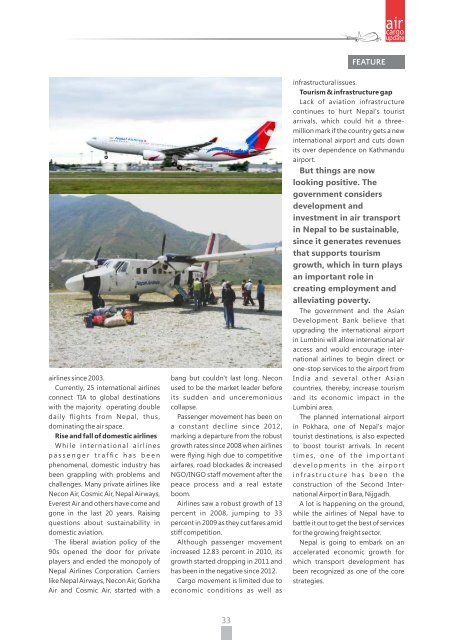You also want an ePaper? Increase the reach of your titles
YUMPU automatically turns print PDFs into web optimized ePapers that Google loves.
FEATURE<br />
airlines since 2003.<br />
Currently, 25 international airlines<br />
connect TIA to global destinations<br />
with the majority operating double<br />
daily flights from Nepal, thus,<br />
dominating the air space.<br />
Rise and fall of domestic airlines<br />
While international airlines<br />
p a s s e n g e r t r a f fi c h a s b e e n<br />
phenomenal, domestic industry has<br />
been grappling with problems and<br />
challenges. Many private airlines like<br />
Necon Air, Cosmic Air, Nepal Airways,<br />
Everest Air and others have come and<br />
gone in the last 20 years. Raising<br />
questions about sustainability in<br />
domestic aviation.<br />
The liberal aviation policy of the<br />
90s opened the door for private<br />
players and ended the monopoly of<br />
Nepal Airlines Corporation. Carriers<br />
like Nepal Airways, Necon Air, Gorkha<br />
Air and Cosmic Air, started with a<br />
bang but couldn't last long. Necon<br />
used to be the market leader before<br />
its sudden and unceremonious<br />
collapse.<br />
Passenger movement has been on<br />
a constant decline since 2012,<br />
marking a departure from the robust<br />
growth rates since 2008 when airlines<br />
were flying high due to competitive<br />
airfares, road blockades & increased<br />
NGO/INGO staff movement after the<br />
peace process and a real estate<br />
boom.<br />
Airlines saw a robust growth of 13<br />
percent in 2008, jumping to 33<br />
percent in 2009 as they cut fares amid<br />
stiff competition.<br />
Although passenger movement<br />
increased 12.83 percent in 2010, its<br />
growth started dropping in 2011 and<br />
has been in the negative since 2012.<br />
Cargo movement is limited due to<br />
economic conditions as well as<br />
infrastructural issues.<br />
Tourism & infrastructure gap<br />
Lack of aviation infrastructure<br />
continues to hurt Nepal's tourist<br />
arrivals, which could hit a threemillion<br />
mark if the country gets a new<br />
international airport and cuts down<br />
its over dependence on Kathmandu<br />
airport.<br />
But things are now<br />
looking positive. The<br />
government considers<br />
development and<br />
investment in air transport<br />
in Nepal to be sustainable,<br />
since it generates revenues<br />
that supports tourism<br />
growth, which in turn plays<br />
an important role in<br />
creating employment and<br />
alleviating poverty.<br />
The government and the Asian<br />
Development Bank believe that<br />
upgrading the international airport<br />
in Lumbini will allow international air<br />
access and would encourage international<br />
airlines to begin direct or<br />
one-stop services to the airport from<br />
India and several other Asian<br />
countries, thereby, increase tourism<br />
and its economic impact in the<br />
Lumbini area.<br />
The planned international airport<br />
in Pokhara, one of Nepal's major<br />
tourist destinations, is also expected<br />
to boost tourist arrivals. In recent<br />
t i m e s , o n e of t h e i m p o r t a n t<br />
d e v e l o p m e n t s i n t h e a i r p o r t<br />
i n f r a s t r u c t u r e h a s b e e n t h e<br />
construction of the Second International<br />
Airport in Bara, Nijgadh.<br />
A lot is happening on the ground,<br />
while the airlines of Nepal have to<br />
battle it out to get the best of services<br />
for the growing freight sector.<br />
Nepal is going to embark on an<br />
accelerated economic growth for<br />
which transport development has<br />
been recognized as one of the core<br />
strategies.

















